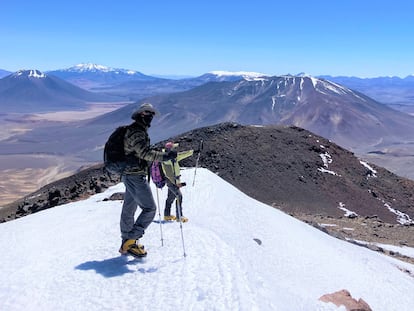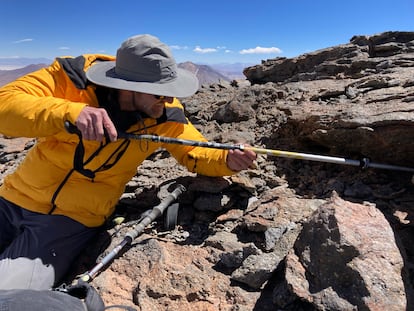Andean leaf-eared mice break the record of highest-dwelling mammals
A group of scientists in Chile are investigating how these South American rodents manage to survive at altitudes where no other vertebrate has ever been seen
At the top of the Andes mountain range, life seems like fiction. There is nothing there. Those immense volcanic peaks that rise over 20,000 feet above sea level are a vacant world of stone, ice and snow.
Between 1970 and 1980, archaeologists climbed some of these volcanoes and found mounds of rocks erected by the Incas, the empire that ruled South America until the early 16th century. They also found mummies attributed to the Capacocha, a ceremony that included child sacrifices. And among those ruins, they noticed the remains of a few mice. The speculation was that those rodents had been carried there, perhaps unwittingly, by the Indigenous people themselves. Nobody thought they arrived on their own.
In 2011, on one of these Andean peaks at about 20,300 feet above sea level, an anthropologist and a doctor found a naturally mummified mouse. Three years later, they fortuitously recorded one of these rodents between rocks and ice, and in 2016 a climber saw a rodent hide in its den at the Llullaillaco, a 22,110-feet massif at the northern part of the border between Chile and Argentina and the second-highest active volcano in the world.
But it was until 2020 that Bolivian climber Mario Pérez Mamani noticed the presence of a rodent.
“A mouse!” he told his partner, Jay Storz, a mountaineer and biologist from the University of Nebraska, who, exhausted and dazed by the altitude, barely noticed the little animal, which quickly hid under a rock. Even so, the American managed to capture it with his hand. It was a Phyllotis vaccarum, also known as leaf-eared mouse, a part of the Sigmodontinae subfamily that is believed to have crossed into South America more than 3 million years ago, when only a few islands linked the north and the south of the continent. These small animals had managed to colonize impossible heights. There was life at the top.

How they reached such heights
That encounter prompted Storz and other biologists to investigate the presence of mice. Between 2020 and 2022 they climbed 24 Andean volcanoes, in Chile, Bolivia and Argentina. On three of these peaks, they found 13 dead rodents: on the volcanoes Púlar (20,450 feet), Copiapó (19,855) and Salín (19,780).
“We found life at the tops of very few,” admits the Nebraska biologist. “And the leaf-eared mouse is the most extreme of all.” According to him, that is the only animal found above 20,000 feet, although they also found remains of other types of rodents at altitudes above 16,400, all from the family Cricetidae, separated from their distant European relatives about 18 million years ago.
A previous hypothesis was that the Incas had something to do with the arrival of these little mice to the peaks; even that some of them snuck into the firewood they carried. “It always seemed crazy to me, because carrying a few sticks on your back, no mouse can endure the trip,” says Guillermo D’Elia, a biologist at the Austral University (Argentina) and one of the co-authors of the study on the leaf-eared mouse published in the journal Current Biology.
The scientist was skeptical, so they used radiocarbon tests to determine the age of the tiny hairy mummies: most were from around 1950, and one of them from approximately 350 years ago. In other words, much more recent than the fallen Inca empire. This study joins others “that suggest that there are mice dwellings in those heights,” says D’Elia. “They are few, but they are there.”
The evidence reinforces the theory that they arrived on their own. The mummies they found are males and females, half and half, as a “natural population” would be, he explains. Although the tendency in mammals is for males to travel to reproduce, the sex of the mice found in these peaks is equal. “If they simply arrived by happenstance, one would expect to find more males than females,” he speculates. “This brings to mind a natural population.”
Taming the peaks
There is still much to learn about this species. This is why biologists continue working to gather more information about these rodents. However, the mission is arduous. Storz had experience in mountaineering, and the rumors of the highest mouse in the world piqued his interest. His two passions intersected.
Each exploration lasts three weeks, as it requires acclimatization to the low oxygen levels at 20,000 feet. Climbers must arrive at the summits before noon, to descend a few hundred feet to the base camp. Or risk storms. Up there, “you usually have time to put an arm around your partner, take a selfie at the top and that’s it, because staying a long time at such heights is dangerous,” explains the American. “But we also need to search for mummies.” They make every second count. “The times we found preserved carcasses, they were visible and we didn’t have to look as hard,” he says. And, however slim, there is always a chance of finding some P. vaccarum.
The mountains of western Bolivia tend to have more snow than those of northern Chile, at the driest desert on the planet, the Atacama. However, beyond that, “at the volcanoes where we find mummies, at first glance, there is no difference with the others,” admits the biologist. “We don’t understand why we found some on some peaks and none on others,” except where there is heavy snow, where they don’t expect to find life. They also found bodies of leaf-eared mice on peaks that had no archaeological remains. “It’s a mystery why mice climb some mountains and not others,” he reflects.

At the top, breathing is difficult. It is exhausting. The mind becomes cloudy. Thinking clearly is hard, but the views are impressive. Lower down — at around 11,500 feet — the arid Atacama Plateau “is the best place in the world to see the night sky,” confesses Storz. “It has a certain charm; it is not for everyone, it is quite austere, almost Martian.”
Two large camelids, vicuñas and guanacos, live there, surrounded by foxes and flamingos in the lagoons. The vegetation is scarce: there are cacti and yaretas, a mossy-looking bush. Up to 3,100 feet, the environment is “a little friendlier,” says D’Elia. “You can imagine what they can eat and what they cannot.” Up to that point, mice are abundant. At that altitude, the cold is severe at night and the lack of oxygen is tangible. “You get dizzy if you bend down and get up quickly,” he explains. “Your head and body work in slow motion.” At night, it is not easy to enter deep sleep as the wind twists and bends the bushes.
These little mice hide among the vegetation and the rocks, becoming more active at night. The researchers set traps to catch and study them. In places like the Casiri lagoon, at 15,750 feet above sea level on the border with Bolivia, “everything is very primitive and rudimentary,” he says. “These are very remote places; you don’t see many people,” except for the occasional local with some livestock. The roads are rough, diffused, slow to travel. “And there comes a point when there is nothing: it’s just sand, volcanic ash, rocks, snow and ice,” he continues. Sulfur fumaroles emerge from the cracks, turning the ground yellow.
The scientists have seen tracks left by a puma, the big cat of the Andes, at 17,100 feet. “It’s impressive that they are so high; I suppose they are hunting vicuñas and guanacos,” says Storz. The elusive Andean mountain cat also lives there, although he has never seen one. “But it is possible that they have seen us,” he says.
Nothing to eat
The absence of predators could be one of the reasons why mice reach so high, the researchers speculate. Although, at 20,000 feet, “they obviously have to deal with other problems,” admits the American.
To D’Elia, it is not surprising that the vertebrates that live at the highest altitude are mammals; there are no lizards or reptiles due to differences in their physiological limits. What is noteworthy, however, is that it happens to be a small rodent. “As you get closer to the poles, or to high altitudes, the animals become larger,” he explains, because they are “more energy efficient.” But not in the Andes.
The biologists assume that the rodents live there year-round and do not migrate. In the laboratory studies, they sequenced the genomes of all 13 mouse bodies and they all belonged to the same species; they compared them with individuals from the highlands and from sea level and barely found any differences between them. “It is as if it were the same large, widely distributed population,” says the scientist.

The certainty that these rodents exist at such altitudes allows them to study the limits of vertebrate life. In Santiago, at the University of Chile, they have some of these mice, captured at lower altitudes; with controlled experiments, they seek to figure out how they evolved for such extreme conditions by comparing them with individuals of “extremely related” species that do not live so high.
But the fact that they are almost genetically identical does not mean that there are no differences, points out D’Elia. More research still needs to be done. However, he speculates on the possibility that they have a gene that “allows hemoglobin at altitude to be more efficient at capturing oxygen.” Another mystery remains: what do they eat, if there is nothing up there? They have only found lichens, highly resistant organisms, made up of a fungus and an algae or cyanobacteria. Analysis of the stomach of a mouse caught in Llullaillaco shows some plants from the Chilean highlands.
For the moment, with their findings they already broke the height record of the large-eared pika (Ochotona macrotis) — more closely related to hares and rabbits — which was found at 20,110 feet, at Mount Everest. “There are still areas that have not been explored much, not only the Chilean Andes, but also the Peruvian, Ecuadorian and Argentinian Andes,” D’Elia explains. “There is a ‘final frontier’ of exploration there, waiting to be visited.”
Sign up for our weekly newsletter to get more English-language news coverage from EL PAÍS USA Edition
Tu suscripción se está usando en otro dispositivo
¿Quieres añadir otro usuario a tu suscripción?
Si continúas leyendo en este dispositivo, no se podrá leer en el otro.
FlechaTu suscripción se está usando en otro dispositivo y solo puedes acceder a EL PAÍS desde un dispositivo a la vez.
Si quieres compartir tu cuenta, cambia tu suscripción a la modalidad Premium, así podrás añadir otro usuario. Cada uno accederá con su propia cuenta de email, lo que os permitirá personalizar vuestra experiencia en EL PAÍS.
¿Tienes una suscripción de empresa? Accede aquí para contratar más cuentas.
En el caso de no saber quién está usando tu cuenta, te recomendamos cambiar tu contraseña aquí.
Si decides continuar compartiendo tu cuenta, este mensaje se mostrará en tu dispositivo y en el de la otra persona que está usando tu cuenta de forma indefinida, afectando a tu experiencia de lectura. Puedes consultar aquí los términos y condiciones de la suscripción digital.
More information
Archived In
Últimas noticias
Most viewed
- Alain Aspect, Nobel laureate in physics: ‘Einstein was so smart that he would have had to recognize quantum entanglement’
- Mexico’s missing people crisis casts a shadow over World Cup venue
- Why oil has been at the center of Venezuela-US conflicts for decades
- Trump clarifies who is ultimately in charge in Venezuela: ‘Me’
- Mexico seeks to shore up its defenses following US incursion in Venezuela










































